
Bruhathkayosaurus is a controversial genus of sauropod dinosaur found in the Kallamedu Formation of India. The fragmentary remains were originally described as a theropod, but it was later determined to be a titanosaurian sauropod. Length estimates by researchers exceed those of the titanosaur Argentinosaurus, as longer than 35 metres (115 ft) and weighing over 80 tonnes. A 2023 estimate placed Bruhathkayosaurus as potentially weighing approximately 110–170 tonnes. If the upper estimates of the 2023 records are accurate, Bruhathkayosaurus may have rivalled the blue whale as one of the largest animals to ever exist. However, all of the estimates are based on the dimensions of the fossils described in Yadagiri and Ayyasami (1987), and in 2017, it was reported that the holotype fossils had disintegrated and no longer exist.

Rajasaurus is a genus of carnivorous abelisaurid theropod dinosaur from the Late Cretaceous of India, containing one species: Rajasaurus narmadensis. The bones were excavated from the Lameta Formation in the Gujarat state of Western India, probably inhabiting what is now the Narmada River Valley. It was formally described by palaeontologist Jeffrey A. Wilson and colleagues in 2003 based on a partial skeleton comprising the braincase, spine, hip bone, legs, and tail–a first for an Indian theropod. The dinosaur likely measured 6.6 metres (22 ft), and had a single horn on the forehead which was probably used for display and head-butting. Like other abelisaurids, Rajasaurus was probably an ambush predator.
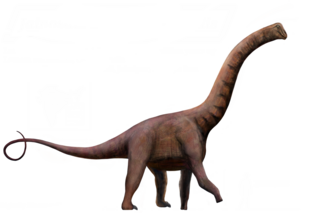
Jainosaurus is a genus of titanosaurian sauropod dinosaur of India and wider Asia, which lived in the Maastrichtian. It is thought to have been about the same size as its contemporary relative Isisaurus, measuring 18 metres (59 ft) long and weighing 15 metric tons. The humerus of the type specimen is 134 centimetres long.
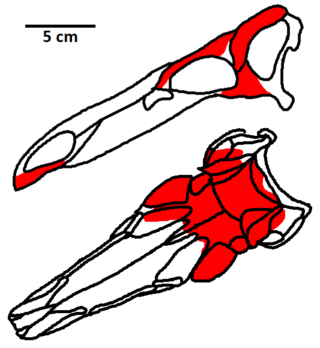
Dravidosaurus is a controversial taxon of Late Cretaceous reptiles, variously interpreted as either a ornithischian dinosaur or a plesiosaur. The genus contains a single species, D. blanfordi, known from mostly poorly preserved fossils from the Coniacian of southern India.

Deltadromeus is a genus of theropod dinosaur from the Aoufous Formation of Morocco.
Brachypodosaurus is a dubious genus of dinosaur, possibly an ornithischian, from the Late Cretaceous Lameta Formation (Maastrichtian) in India.

Indosaurus is a genus of carnivorous theropod dinosaur that lived in what is now India, about 69 to 66 million years ago during the Maastrichtian division of the Late Cretaceous.

Compsosuchus is a dubious genus of abelisauroid dinosaur from the Late Cretaceous Lameta Formation of India.

Isisaurus is a genus of titanosaurian dinosaur from the Late Cretaceous Lameta Formation of India and Pab Formation of Pakistan. The genus contains a single species, Isisaurus colberti.
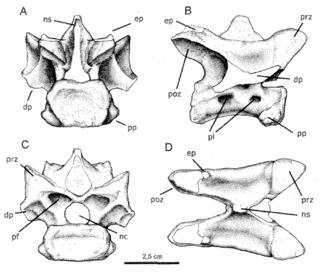
Laevisuchus is a genus of theropod dinosaur from the Late Cretaceous. Its remains were discovered by Charles Alfred Matley near Jabalpur in Maastrichtian "Carnosaur Bed" deposits in the Lameta Formation in Madhya Pradesh, central India, and were named and described by paleontologists Friedrich von Huene and Matley in 1933.

Lametasaurus named for the Lameta Formation, Jabalpur, India, is the generic name given to a possibly chimeric dinosaur species. The type species is L. indicus.

Ornithomimoides is a dubious genus of theropod dinosaur, from the Late Cretaceous Lameta Formation of India. Two species have been identified, the type species O. mobilis and O. barasimlensis, were named by von Huene in 1932 and were described by Matley in 1933 though they are known only from isolated vertebrae. O. barasimlensis is known from five dorsal vertebrae, and O. mobilis from four smaller vertebrae, found at the same location.
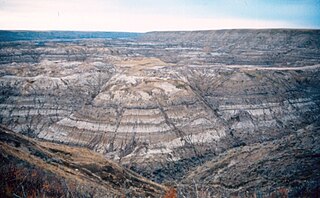
The Horseshoe Canyon Formation is a stratigraphic unit of the Western Canada Sedimentary Basin in southwestern Alberta. It takes its name from Horseshoe Canyon, an area of badlands near Drumheller.
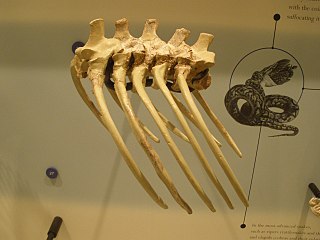
Madtsoiidae is an extinct family of mostly Gondwanan snakes with a fossil record extending from early Cenomanian to late Pleistocene strata located in South America, Africa, India, Australia and Southern Europe. Madtsoiidae include very primitive snakes, which like extant boas and pythons would likely dispatch their prey by constriction. Genera include some of the longest snakes known such as Vasuki, measuring at least 11–15 metres (36–49 ft) long, and the Australian Wonambi and Yurlunggur. As a grouping of basal forms the composition and even the validity of Madtsoiidae is in a state of flux as new pertinent finds are described, with more recent evidence suggesting that it is paraphyletic as previously defined.
The Maevarano Formation is a Late Cretaceous sedimentary rock formation found in the Mahajanga Province of northwestern Madagascar. It is most likely Maastrichtian in age, and records a seasonal, semiarid environment with rivers that had greatly varying discharges. Notable animal fossils recovered include the theropod dinosaur Majungasaurus, the early bird Vorona, the paravian Rahonavis, the titanosaurian sauropod Rapetosaurus, and the giant frog Beelzebufo.
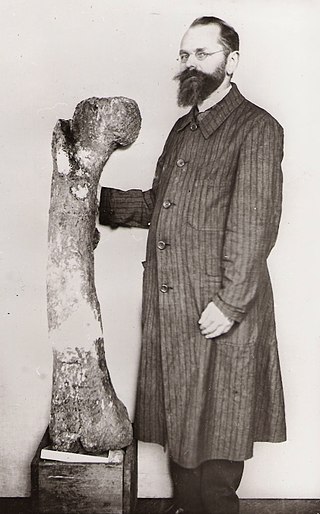
Bahariasauridae is a potential family of averostran theropods that might include a handful of African and South American genera, such as Aoniraptor, Bahariasaurus, Deltadromeus, and Gualicho. The placement of these theropods is controversial, with some studies placing them as basal ceratosaurs possibly related to Noasauridae, others classifying them as megaraptorans, basal neovenatorids, or basal coelurosaurs. There is also a possibility the group might not be monophyletic, as a monograph on the vertebrate diversity in the Kem Kem Beds published in 2020 found Bahariasaurus to be nomen dubium. In the same paper Deltadromeus is classified as an noasaurid, a result also recovered by some previous studies. A 2024 analysis found Aoniraptor, Bahariasaurus, Deltadromeus, Elaphrosaurus and Gualicho to form a monophyletic clade at the base of Ceratosauria.
The Intertrappean Beds are a Late Cretaceous and Early Paleocene geologic formation in India. The beds are found as interbeds between Deccan Traps layers, including the slightly older Lameta Formation. The formation spans the Cretaceous–Paleogene boundary, with a stratigraphic range of only a few hundred thousand years before and after the boundary, and a significant debate exists about whether specific sites belong to the Cretaceous or the Paleocene.

Rahiolisaurus is a genus of abelisaurid theropod dinosaur which existed in India during the Late Cretaceous period. It was described in 2010, based on fossils recovered from the Lameta Formation in the Indian state of Gujarat. These fossils include elements from at least seven different individuals and are believed to have been from the Maastrichtian stage, sometime between 70 and 66 million years ago, making it one of the last non-avian dinosaurs known in the fossil record. Despite representing a variety of different growth stages, all recovered fossils from the locality indicate a single species, the type species Rahiolisaurus gujaratensis.

Camarillasaurus is a genus of theropod dinosaur from the Early Cretaceous period (Barremian) of Camarillas, Teruel Province, in what is now northeastern Spain. Described in 2014, it was originally identified as a ceratosaurian theropod, but later studies suggested affinities to the Spinosauridae. If it does represent a spinosaur, Camarillasaurus would be one of five spinosaurid taxa known from the Iberian peninsula, the others being Iberospinus, Protathlitis, Riojavenatrix, and Vallibonavenatrix.

























